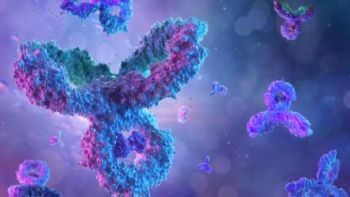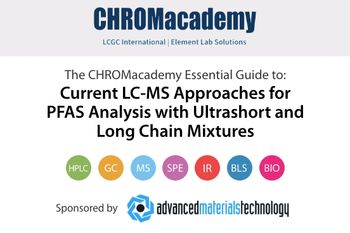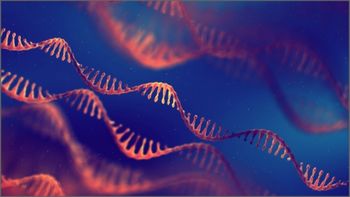
The 2025 LCGC International PFAS Summit
Webinar Date/Time: Tuesday, March 25th, and Wednesday, March 26th, 2025 Morning Session: 9:30 am EDT | 6:30 am PDT | 1:30 pm GMT | 2:30 pm CET Afternoon Session: 11:30 am EDT | 8:30 am PDT | 3:30 pm GMT | 4:30 pm CET
Explore the latest techniques and best practices for analyzing PFAS in food and environmental samples at this interactive symposium.
Register Free:
Event Overview:
Building on the success of LCGC’s PFAS Summit in 2024, LCGC International is thrilled to introduce another interactive, two-day virtual symposium aimed at laboratory scientists specializing in the analysis of PFAS (per-and poly-fluoroalkyl substances) and who need to keep abreast of the latest analytic advances using chromatographic techniques. This event will showcase the latest techniques and best practices for analyzing PFAS in food and environmental samples. Each day features two sessions, with a live Q&A following the first session to provide expert insights and foster meaningful discussions.
The second session on both days will contain presentations from leading chromatography companies, who will demonstrate how their cutting-edge technologies benefit separation scientists working to analyze PFAS in food and environmental samples.
Top Reasons to Attend:
- Learn state-of-the art separation science techniques to analyze PFAS.
- Leading scientists reveal the cutting-edge chromatographic techniques used to analyze PFAS in food and environmental applications.
- Learn about the modern separation science techniques used to analyze PFAS in food and environmental samples.
Who Should Attend: Laboratory scientists involved in research and routine analysis of PFAS for food and environmental analysis.
Event Agenda
Tuesday, March 25th, 2025
Day 1: PFAS in Food Analysis
9:30 am EDT Non-Targeted Screening for PFAS in Complex Food Matrices: Keys to Data Prioritization
Nicolas Macorp, Postdoctoral researcher, Oniris, INRAE, LABERCA, France
10:00 am EDT AOAC International, PFAS Standard Development Initiatives
Constance Bahr, Manager of Science Programs, AOAC International, Rockville, Maryland, USA
Andrew Savage, Expert Chemist, Nestle Quality Assurance Center
10:30 am EDT Analytical Strategies for PFAS Analysis in Food
Xanthippe Theurillat, Société des Produits Nestlé, Research Center, Lausanne, Switzerland
11:00 am EDT Q&A
11:30 am EDT Streamlining EPA 1633 Compliance: Automated Sample Extraction & Cleanup for PFAS in Solids and Fish Tissues
Kari Organtini, PhD, Principal Scientist, Waters
11:50 am EDT Incorporating Ultrashort-Chain Compounds into the Comprehensive Analysis of PFAS
Shun-Hsin Liang, PhD, Senior Principal Scientist LC Solutions, Restek
12:10 pm EDT Combustion IC for Non-Targeted PFAS Monitoring in Consumer Products
Sylvia Singh, IC Applications Specialist, Metrohm
12:30 pm EDT Fully Automated Quantitation of PFAS in Seafood
M. Lorna De Leoz, Global Food Segment Director at Agilent
Aimei Zou, Solution Scientist at Global Solution Development Center at Agilent
Wednesday, March 26th, 2025
Day 2: PFAS in Environmental Analysis
9:30 am EDT Tackling Tiny PFAS: A Trustworthy Tool for Thorough Testing
Ruben Kause, Researcher; MSc, Wageningen Food Research, The Netherlands
10:00 am EDT Non-targeted Analysis of PFAS. What Is Actually in Our Environment?
David Megson, Reader in Chemistry and Environmental Forensics, Manchester Met University (UK) & Chemistry Matters (Canada)
10:30 am EDT A Deep Dive into PFAS Marine Contamination: Advanced Suspect Screening in French Coastal Bivalves
Ninon Serre, Environmental and analytical chemist, PhD candidate, Ifremer, French national institute for ocean science and technology, Nantes, France
11:00 am EDT Challenges and Significance of Measuring PFAS in Soils, Biosolids and Plants
Sébastien Sauvé, Université de Montréal, Montreal, Canada
11:30 am EDT Q&A
12:00 pm EDT Analyzing Ultrashort-Chain PFAS
Kendra Adams, Application Scientist, SCIEX
12:20 pm EDT Monitoring Volatile PFAS Emissions from Production to Destruction
Hannah Calder, Environmental – Market Development Manager, Markes
12:40 pm EDT Comprehensive Solutions for PFAS Analysis
Dr. Stan Lok, Senior Product Specialist, GL Sciences Inc.
1:00 pm EDT Non-Targeted Analysis of PFAS in Dust Samples using Multidimensional Chromatography, High-resolution Mass Spectrometry, and Scaled Mass Defect Plots
David Alonso, Applications Chemist - Separation Science, LECO
1:20 pm EDT PFAS Analysis according to European Union’s Directive 2020/2184
Marcus Chadha, LC/MS Field Application Specialist, Agilent
1:40 EDT PFAS Sample Preparation for Challenging Samples: Environmental to Tissue and Beyond
Alicia Stell, Market Development Manager, CEM Corporation
2:00 EDT Experience Maximized Productivity for PFAS Analysis Even with Complex Matrices
Tom Hey, Environmental Market Leader, PerkinElmer
Speakers:
Nicolas Macorp
Postdoctoral researcher
Oniris, INRAE, LABERCA, France
Nicolas Macorp first encountered the world of PFAS and its vast array of individual compounds during his PhD in analytical and environmental chemistry. At that time, he was working with conventional targeted analysis but was already trying to cover many PFAS and exploring alternative approaches with the TOP assay to increase analytical coverage. Nicolas was later recruited as a postdoctoral researcher at LABERCA to continue working on the PFAS problem. His research projects revolve around PFAS analysis in complex matrices, with efforts to identify unsuspected and unknown PFAS.
Constance Bahr
Manager of Science Programs
AOAC International
Rockville, Maryland, USA
Constance Bahr is a Manager of Science Programs, reporting to the Deputy Assistant Executive Director & Chief Standards Officer. She has been with AOAC International since 2022. Before her position at AOAC, she worked as a project manager, lead microbiologist, and analytical chemist at a startup making biodegradable biopolymers. She also spent years researching the gut microbiome and protein crystallography as a research technician and laboratory manager at the University of Queensland and the University of Michigan, respectively. She graduated from the University of Michigan with a BSc in biomolecular science in 2010. Outside work, she enjoys traveling, being in nature, and painting.
Xanthippe Theurillat
Société des Produits Nestlé
Research Center
Lausanne, Switzerland
Xanthippe Theurillat is an analytical chemist. In 2012, she joined the Official Food Control Laboratory in Lausanne, Switzerland, as a scientific expert in the contaminants section and in 2015, she joined Nestlé Research in Lausanne, Switzerland, as an analytical scientist in the Analytical Science Department in the field of food contaminants with a specific focus on pesticides, polyphenols, process contaminants–including the mechanistic understanding for the latter–and PFAS.
Ruben Kause, Researcher; MS
Wageningen Food Research
The Netherlands
Ruben Kause is a scientist at Wageningen Food Safety Research (WFSR, Wageningen, The Netherlands) with a background in analytical chemistry, materials science, and environmental sciences. Ruben started his career as an air pollution specialist, focusing on air distribution and deposition modeling. For two years, he worked as an air specialist at Royal HaskoningDHV, advising regulatory authorities and large commercial parties on their air emissions regarding (local) legislation. Since 2020, Ruben has returned to the lab as a researcher at Wageningen Food Safety Research. There, he became involved in method development for PFAS analysis and several large-scale studies in the Netherlands. Ruben is a passionate researcher with a heart for science. In his talk, Ruben aims to introduce innovative tools for studying short-chain PFASs, helping to enhance our understanding of their impact.
David Megson
Reader in Chemistry and Environmental Forensics
Manchester Met University (UK) & Chemistry Matters (Canada)
Dr. Megson investigates sources of legacy and emerging persistent organic pollutants and monitors them in the environment using advanced analytical techniques including multidimensional chromatography and high-resolution mass spectrometry. Much of Dr Megson’s research has an environmental forensics aspect, which involves identifying the sources of contamination, transport pathways, and the magnitude of pollutant exposure. Dr Megson regularly contributes as a recognized international expert to witness reports for large (>$100 million) litigation cases involving environmental pollution in North America. His current research group includes 6 PhD students and two postdoctoral researchers. He has attracted >£4.5 million of research funding since he was appointed a lecturer in 2016. Recently, he has been investigating the scale of PFAS pollution in the UK and has published papers investigating releases from industrial sites and wastewater treatment plants.
Ninon Serre
Environmental and analytical chemist, PhD candidate
Ifremer, French national institute for ocean science and technology
Nantes, France
Ninon Serre is a PhD candidate at the French national institute for ocean science and technology (Ifremer). Passionate about applying cutting-edge analytical methods to uncover previously undetected pollutants, she specialized in environmental chemistry and the study of emerging contaminants, particularly per- and polyfluoroalkyl substances (PFAS). Her current research includes leveraging advanced high-resolution mass spectrometry (HRMS) techniques, such as suspect and non-target screening, to identify and characterize the breadth of PFAS contamination in marine ecosystems
Sébastien Sauvé
Université de Montréal
Montreal, Canada
Sébastien Sauvé is Professor of Environmental Chemistry at the Université de Montréal. He has more than 300 scientific articles to his credit on a variety of subjects ranging from the study of contaminated soils, the circular economy, blue-green algae, ultra-trace analysis by mass spectrometry and the impact of emerging contaminants on human health and the environment. He is particularly active in popularizing his research, with hundreds of appearances in the media. He is a member of the Royal Society of Canada, a correspondent of the Académie d'agriculture de France and was awarded the Prix Michel-Jurdant en Environnement by ACFAS in 2020.
Kari Organtini, PhD
Principal Scientist
Waters Corporation
Kari Organtini is a Principal Scientist at Waters Corporation and has been with the company for ten years. She received her PhD from Penn State University in 2015 studying the occurrence of dioxins and furans in fire debris and their implications to first responder health. At Waters, Kari is part of the PFAS Program within the Research, Development and Advanced Testing Group. During her career, Kari has developed applications using both LC and GC techniques for a variety of applications ranging from pesticides to persistent organic pollutants. She is currently the scientific lead for developing PFAS applications at Waters and has been working with this group of compounds since 2017.
Kendra Adams
Application Scientist
SCIEX
Kendra Adams is an Application Scientist at SCIEX, specializing in food and environmental applications for North America. She received her PhD in Chemistry from Florida International University, where she developed advanced methods for analyzing biological samples. She also conducted postdoctoral research at Duke University, focusing on Alzheimer's disease biomarkers
Andrew Savage
Expert Chemist
Nestle Quality Assurance Center
Andrew Savage is an Expert Chemist at Nestle Quality Assurance Center in Dublin, Ohio, where he leads projects for new analyses and technology scouting. He is involved with several AOAC working groups and serves as the Ohio Representative on the Board of Directors for the AOAC INTERNATIONAL Midwest Section. His focus is chemical contaminants in food and he was previously the Supervisor of the NQAC Contaminants Laboratory, where he managed the performance of 40 trace-level analytical methods. He has 25 years of experience in analytical laboratories within academia, contract research, and in the food industry, working primarily in mass spectrometry. He holds a Bachelor of Science from Mount St. Joseph University, PCQI certification, and enjoys sailing in his free time.
Hannah Calder
Environmental – Market Development Manager
Markes International
Hannah Calder is Market Development Manager for the Environmental sector at Markes International, specialising in the application of thermal desorption in environmental monitoring. Hannah is involved with development of international analytical standards for monitoring of organic compounds in ambient and indoor air through CEN, ASTM and ISO. Most recently she contributed to the writing of a new ASTM standard on monitoring of fluorotelomer alcohols from emissions chambers.
Dr. Stan Lok
Senior Product Specialist
GL Sciences Inc. Marketing Group
Dr. Lok, Senior Product Specialist at GL Sciences, has extensive expertise in chromatography, providing global application support, troubleshooting, and technical training. He has contributed to chromatography advancements by developing analytical methodologies, optimizing column technologies, and training scientists and technicians. Previously, he worked as a research chemist at Kao Corporation and Trivascular. Dr. Lok holds a BSc from Harvey Mudd College and an M.S. and Ph.D. in Chemistry from UC San Diego. His dedication to innovation and education continues to enhance analytical solutions and support customers worldwide.
David Alonso
Applications Chemist - Separation Science
LECO Corporation
Dr. David Alonso is an Applications Chemist for LECO’s Separation Science product line. He has been at LECO for 14 years and has developed applications in several markets including, but not limited to Environmental, Metabolomics, and Forensics.
Shun-Hsin Liang, PhD
Senior Principal Scientist LC Solutions
Restek Corporation
Shun-Hsin is a senior LC applications scientist at Restek. He received his bachelor’s degree from the National Taiwan University in 1988 and obtained his PhD from Michigan State University in 1996. He performed postdoctoral research at the University of Michigan from 1996 to 2000 for oncology studies. In 2001, he was appointed as research faculty at The Pennsylvania State University and focused on molecular toxicology research. In 2006, he joined MPI Research Inc. as a senior research scientist and was a study director for GLP analytical projects. In 2013, Dr. Liang joined the LC Solutions department at Restek and specialized in developing application methods across the fields of environmental, food safety, and life sciences.
Sylvia Singh
IC Applications Specialist
Metrohm USA
Dr. Sylvia Singh is the Applications Specialist for Ion Chromatography at Metrohm USA in Riverview, Florida. She earned her PhD in Chemistry with a focus on Bioorganic Chemistry at the University of South Florida (USF). At USF, Sylvia worked as a researcher and Teaching Assistant within the Chemistry Department. During her time with Metrohm USA, she continues to represent the voice of the customer while working on application growth through lab project feasibility studies, technical and applications support, as well as product support.
M. Lorna De Leoz
Global Food Segment Director
Agilent Technologies
Lorna De Leoz is the Global Food Segment Director at Agilent. She supports scientists to ensure and advance the safety, quality and authenticity of the food we eat through accurate and reliable testing. Previously, Lorna worked at the National Institute of Standards and Technology (NIST) and as a research scientist at the Philippine Institute of Pure and Applied Chemistry, a contract testing laboratory, and as a wide area network administrator at San Miguel, a food manufacturing company. Lorna’s Ph.D. in Chemistry at University of California, Davis studied milk oligosaccharides and glycan biomarkers through high resolution mass spectrometry.
Aimei Zou
Solution Scientist at Global Solution Development Center
Agilent Technologies
Aimei Zou is a Solution Scientist at Global Solution Development Center, Agilent Technologies. She earned her PhD in Analytical Chemistry in 2008 and brings over 16 years of extensive experience in in food and environmental method development. Aimei has successfully developed PFAS dMRM Database and created PFAS applications for seafood, food contact, and packaging materials. Previously, Aimei worked as a Chemistry Specialist at Nestle Singapore, and as a Scientist at the Health Sciences Authority Singapore.
Marcus Chadha
LC/MS Field Application Specialist
Agilent Technologies
Marcus Chadha has a PhD in biochemistry where he developed novel approaches for characterizing exopolysaccharides by LC-HRAM and 2D-NMR. He then worked as a Laboratory Manager for a contract research lab where he headed the LC-MS facility. Marcus joined Agilent in 2016 where he first was an LC-MS Field Application Specialist before becoming the EMEA Applications Specialist Manager 3 years ago. In his roles, he has collaborated with environmental and food customers, developed new methods.
Dr. Alicia Stell, PhD
Market Development Manager
CEM Corporation
Dr. Alicia Douglas Stell has worked with CEM for the past 17 years, joining after completing her PhD in Analytical Chemistry. Her extensive background in chromatographic analysis and her mechanical expertise have been instrumental in the development of the EDGE solvent extraction system and its applications. She has been leading the EDGE product since its inception and traveled the world to identify new markets develop applications for this innovative technology.
Tom Hey
Environmental Market Leader
PerkinElmer
Tom is the Environmental Market Leader at PerkinElmer, applying his sales and management experience from Key Account Manager and Business Leader positions since joining in 2015. Holding a Ph.D. in Inorganic Chemistry from the University of Bristol, he leverages his problem-solving skills when tackling environmental solutions. Tom’s passion lies in enhancing PerkinElmer's offerings, particularly in tackling environmental challenges like PFAS and microplastics.
Register Free:
Newsletter
Join the global community of analytical scientists who trust LCGC for insights on the latest techniques, trends, and expert solutions in chromatography.




